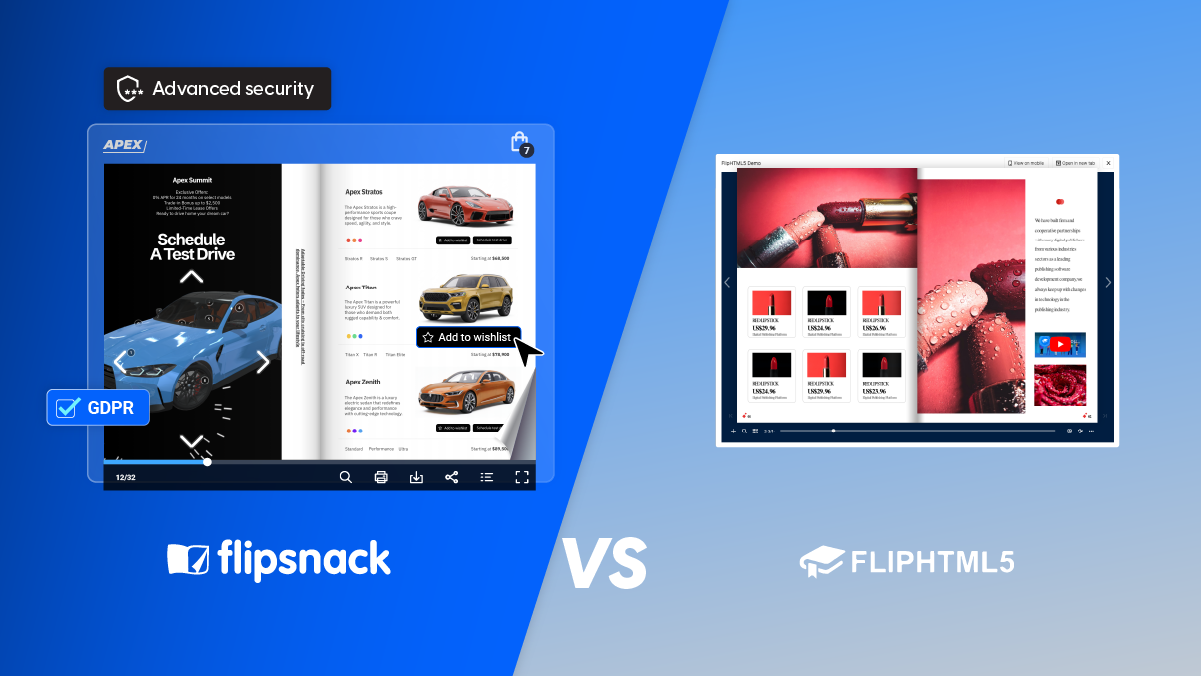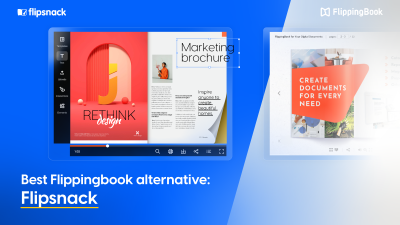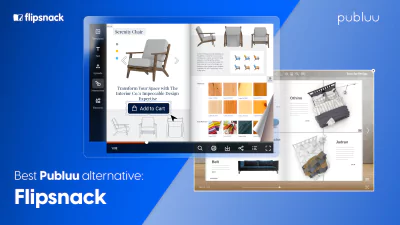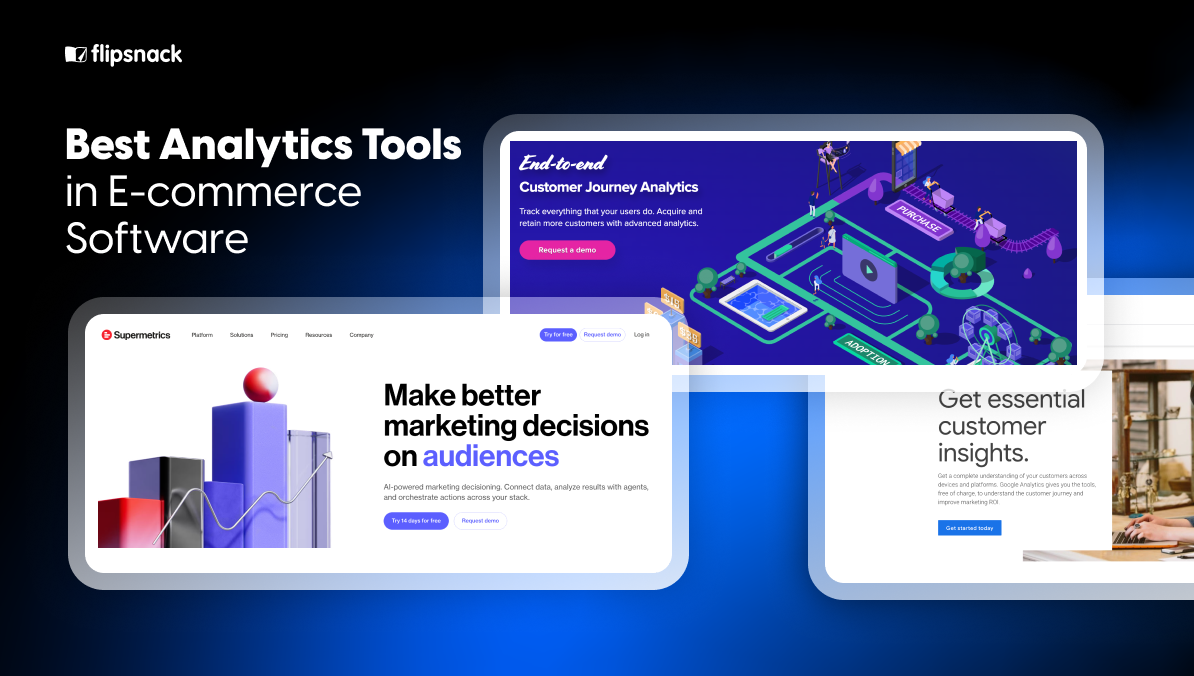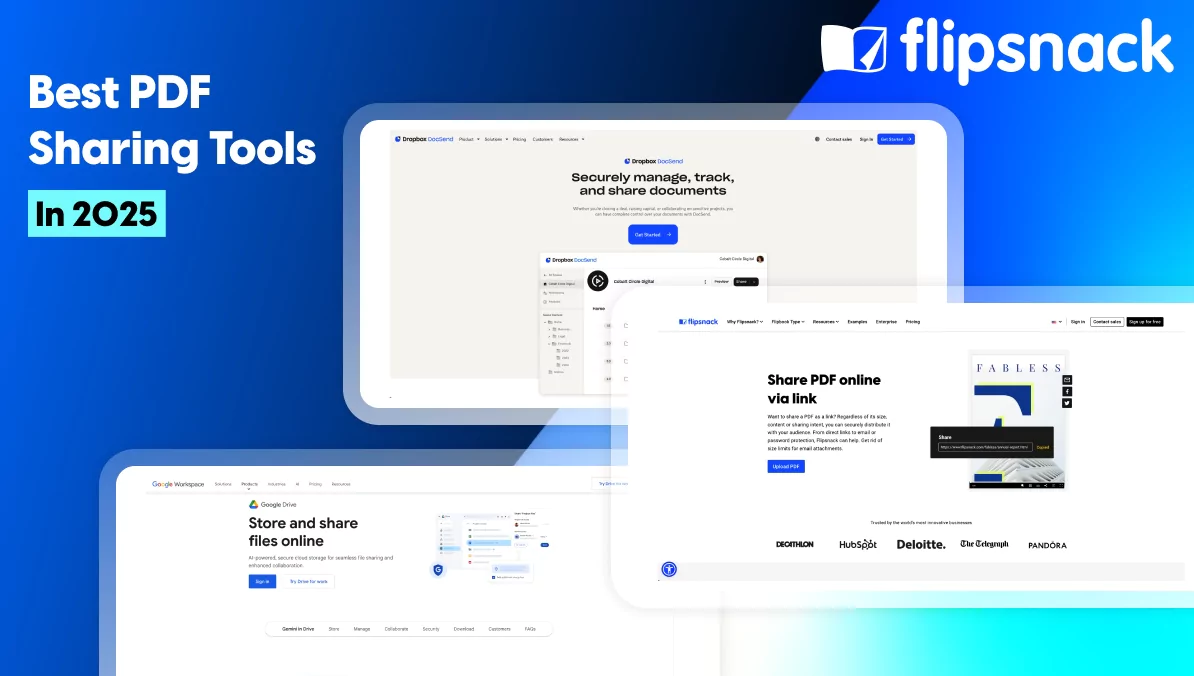Flipsnack vs. FlipHTML5: Which digital flipbook software is better
Last updated: April 29th, 2025
If you’re searching for a digital flipbook alternative for your business, this in-depth comparison of Flipsnack vs. FlipHTML5 is for you. Both Flipsnack and FlipHTML5 are popular digital flipbook platforms that turn static PDFs into interactive, engaging publications. But how do they stack up for enterprise organizations with high demands on security, collaboration, and scalability?
In this article, we’ll compare Flipsnack vs. FlipHTML5 across all the key decision factors that matter to your business: advanced interactivity, security and compliance, team collaboration, branding and white-labeling, scalability and automation, analytics, integrations, and the latest AI features and accessibility tools.
Digital flipbooks have revolutionized the way we present and share content online. Unlike traditional PDFs, flipbooks offer an interactive and visually engaging experience, mimicking the look and feel of a physical book. They are ideal for showcasing magazines, product catalogs, brochures, and more, providing a dynamic reading experience that captivates audiences. Choosing the right flipbook maker is crucial for maximizing these benefits and ensuring a seamless user experience.
Large companies require more than basic flipbook functionality – they need robust security, flexible branding, multi-user collaboration, and enterprise-grade integrations. Read on for a head-to-head comparison that will help you determine which platform is the best FlipHTML5 alternative for your organization’s needs.

Table of contents
- More than 9 million professionals choose Flipsnack’s flipbook maker
- Flipsnack vs. FlipHTML5 : a side-by-side comparison
- Advanced interactivity & engagement tools
- Team collaboration and permission control
- Analytics & Insights
- Integrations (CRM, Adobe, etc.)
- Flipsnack vs FlipHTML5: AI for Accessibility and Efficiency
- FlipHTML5 vs Flipsnack? And why Flipsnack is better for your business needs
More than 9 million professionals choose Flipsnack’s flipbook maker
Flipsnack’s capabilities as a complex flipbook software exceeds other tools on the market. From the get go, it has the fastest PDF to flipbook converter, allowing you to bulk upload PDFs with hundreds of pages and convert them in a matter of minutes. But once you access your flipbook, that’s where the real transformation takes place.
The Design Studio is packed with interactions, from simple hyperlinks to shopping list technology that allows your clients to order products directly from the catalog. It also offers extensive sharing options, public and private depending on your documents’ intent and audience. And the usefulness of Flipsnack doesn’t end here. You can also track how your documents or flipbooks perform by checking the built-in statistics. Take a look at what our clients say about their experience with Flipsnack and see for yourself.
See what our users are saying about Flipsnack


Flipsnack is a catalyst in the transition to a more sustainable business. It combines the feeling that a paper catalog gives with interactive and easy-to-use multimedia features that take the user experience to the next level.

Flipsnack is a great PDF converter tool for interactive storytelling that funnels into lead generation and conversion – all within the same ecosystem!

Flipsnack has been a great tool for our HR Team’s communication needs. Their range of wonderful security options for our documents was the #1 selling point!

To say that using Flipsnack has been a success is an understatement. We’ve seen an increase in knowledge and engagement–which is strictly due to Flipsnack! Our training content has never been more organized and easy to access.

Most of my clients thought we spent hours and days creating the Flipbooks when in fact it only took minutes to upload a PDF. I have now built out templated guides with several versions of each. Now when a new client comes on I just have to add a customized cover page and change fonts and colors to match my client’s branding standards.
Flipsnack vs. FlipHTML5: a side-by-side comparison
The two flipbook makers both enable you to create HTML5 flipbooks from PDFs and other documents, complete with interactive media. Flipsnack is an enterprise-ready solution with an integrated Design Studio, an extensive template library, and advanced features for interactivity, security, and analytics. It’s a secure, reliable platform built to meet the needs of big businesses and teams.
FlipHTML5, on the other hand, is a versatile digital publishing tool often favored by individuals or small businesses; it converts PDFs into interactive flipbooks with multimedia and even offers an AI assistant for content creation. However, FlipHTML5 is generally considered a better fit for small businesses with limited budgets and simpler requirements. As we’ll see below, FlipHTML5 provides core flipbook capabilities but is not built to accommodate larger companies with advanced collaboration or security needs
In short, Flipsnack targets professional and enterprise users by delivering a more extensive feature set and enterprise support, while FlipHTML5 covers the basics for creating interactive publications.
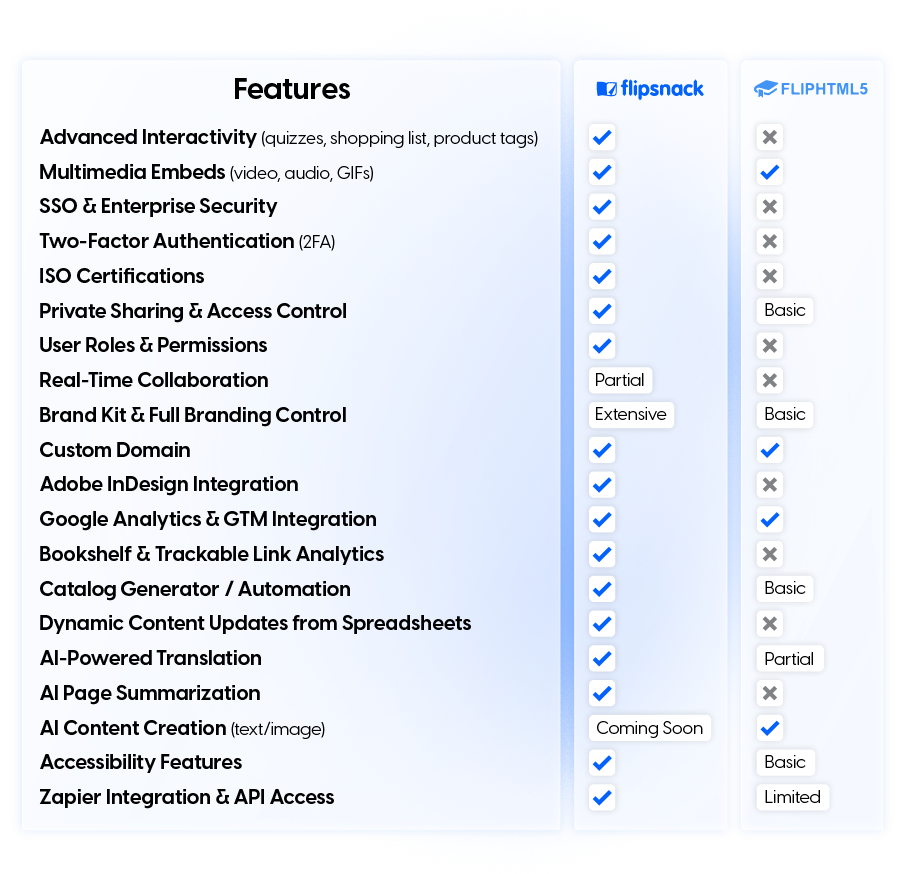
Now, let’s get into more detailed comparisons of each critical feature area to help you make the best decision.
Note: Use Flipsnack’s free trial to see how most premium features work. For basic PDF interactivity and up to three flipbooks, you can stay on the free plan.
Advanced interactivity & engagement tools
When it comes to interactive and engaging content, both Flipsnack and FlipHTML5 support standard rich media like hyperlinks, embedded videos, audio, GIFs, and interactive forms in their flipbooks. This means you can embed multimedia and clickable elements in catalogs, magazines, or brochures on either platform.
Flipsnack vs FlipHTML5: Business-ready interactivity
Flipsnack offers a more comprehensive range of interactive features made to business needs, whereas FlipHTML5 provides more basic options with a focus on multimedia and animations.
Flipsnack goes beyond the basics with interactive elements designed to increase engagement and conversions. It supports interactive tables and charts, lead capture forms, and uniquely, it offers shoppable features like product tags and shopping buttons directly inside your flipbooks.
For example, retail and wholesale companies can enable a shopping list in a digital catalog so customers can “add to cart” or order products straight from the flipbook. Flipsnack also includes feedback tools such as quizzes, polls, and question directly from the flipbook. These advanced interactivity tools help keep readers engaged and drive actions, which is ideal for marketing, sales, or training content in a business setting.
FlipHTML5 covers the common interactive elements (links, videos, audio, etc.) and even allows the design of animated page transitions or slideshow-like effects. In fact, FlipHTML5 lets creative users add animations and motion effects to mimic presentation slides or bring static content to life. It also introduced an AI assistant that can help generate or improve content.
These capabilities can be useful for individual creators or designers who want to add flair to their projects. However, FlipHTML5 lacks the more business-oriented interactive tools that Flipsnack provides – features like built-in quizzes, shopping integrations, or product tagging are absent. Additionally, some users find FlipHTML5’s interface for adding complex interactions less intuitive, resulting in a steeper learning curve to fully leverage its animation features.
FlipHTML5’s interactive features can certainly make content more engaging than a PDF, but they may not directly support lead generation or e-commerce the way Flipsnack’s do. For a business looking to maximize engagement and track conversions from their content, Flipsnack provides a more versatile toolkit.
Security and compliance (SSO, encryption, certifications)
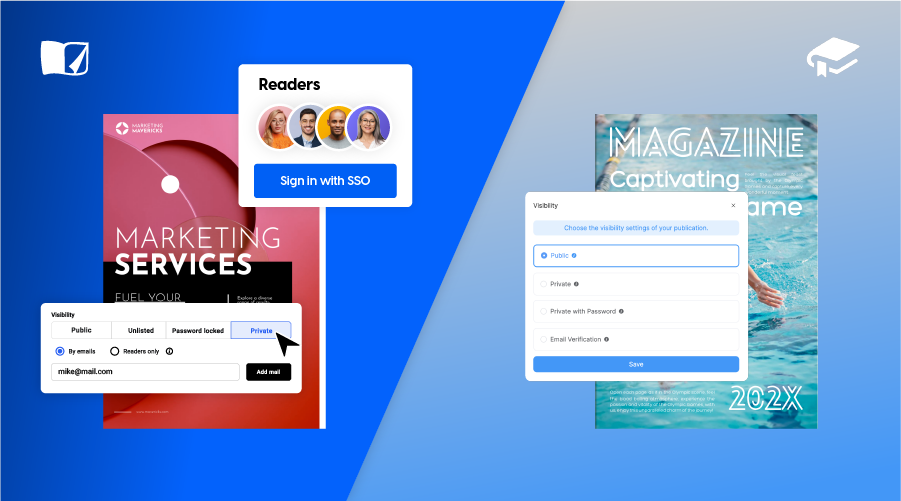
Flipsnack’s enterprise-grade security
When it comes to enterprise software, security isn’t just a feature; it’s a requirement. Flipsnack offers a robust security framework that goes far beyond what FlipHTML5 provides, making it the preferred choice for industries like finance, healthcare, and others that handle sensitive information.
Flipsnack keeps your content safe, secure, and compliant with features designed for large organizations:
- Single Sign-On (SSO): Enable secure access through your identity provider (e.g., Okta, Azure AD) for both internal users and external readers—perfect for sharing private content or internal documents.
- Two-Factor Authentication (2FA): Add an extra layer of login protection for all users.
- Granular Access Control: Set custom permissions, restrict access with private links, passwords or passcode, and ensure only authorized users can view sensitive materials.
- Enterprise Compliance: Fully GDPR-compliant and certified under ISO 27001 (Information Security), ISO 9001 (Quality Management), and ISO 20000-1 (IT Service Management).
- End-to-End Encryption: Data is encrypted both in transit and at rest for maximum protection.
These measures demonstrate a strong commitment to enterprise security best practices. In short, Flipsnack provides a secure environment for sensitive content, making it suitable for large companies that can’t compromise on security or compliance.
FlipHTML5’s basic privacy features
FlipHTML5, by contrast, offers more basic security features. The platform lets users set password protection on Flipbooks and share private (unlisted) links, which does help restrict access to general audiences. For many individual users or small businesses, these simple privacy options (e.g., marking a document as private or requiring a password) are adequate. However, FlipHTML5 lacks enterprise-focused security capabilities – there is no SSO integration, no two-factor auth, and no advanced permission management per user.
Essentially, every FlipHTML5 account stands alone without an enterprise SSO tie-in, which can be a dealbreaker for company-wide deployments. It does support content being offline or downloadable, but it does not advertise encryption standards or industry certifications like ISO. Its security settings are relatively static (on/off) and not as customizable or robust as Flipsnack’s.
For example, you cannot centrally manage user roles or expiring access in FlipHTML5 – it’s mostly limited to setting a password on a document. These limitations mean that while FlipHTML5’s basic privacy is fine for general use, it may fall short of the stringent requirements of enterprises dealing with confidential data.

Team collaboration and permission control
For organizations where multiple team members work together on content, Flipsnack offers a collaborative workspace built for teams, while FlipHTML5 is primarily a single-user tool with minimal collaboration support. This is a critical difference for marketing or creative teams in larger companies that need to co-create and manage content collectively.
Flipsnack’s collaboration and team features
Flipsnack provides a robust team collaboration environment. Companies can invite team members into a shared workspace on Flipsnack and assign user roles (e.g. Admin, Editor, Contributor) with different editing or viewing permissions. This permission control ensures each person has appropriate access to create or publish content.
Team members can easily share flipbooks and even share collections or folders of flipbooks with the entire team privately. Flipsnack also includes a commenting system and version control, allowing reviewers to leave feedback directly on flipbook pages and creators to iterate efficiently (important for internal approval workflows).
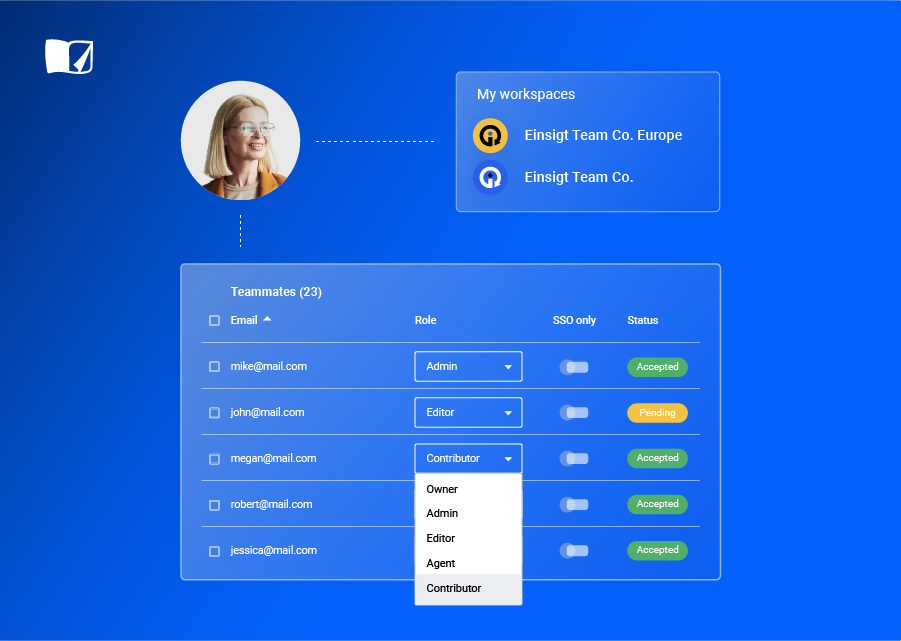
In fact, Flipsnack offers real-time collaboration where multiple team members can edit and take over flipbooks, along with shared workspaces and live commenting to facilitate communication.
Overall, Flipsnack’s collaboration features are tailored to streamline workflows in large teams, with everything from team templates to the organization of users into multiple workspaces for different departments.
Limited collaboration in FlipHTML5
FlipHTML5 is more geared toward individual use and, therefore, offers only very limited collaboration functionality. There is no multi-user account structure or roles — typically, one account equals one user. FlipHTML5 does allow you to share a project or have someone review a flipbook by sending them a link, similar to sending a document for review, but it does not support real-time multi-user editing or any in-app workflow for team feedback.
Essentially, team collaboration in FlipHTML5 is restricted to manual workarounds (for example, one person creates the flipbook, then shares the published link or file with others via email for feedback). There’s no concept of a shared workspace, no built-in commenting system, and no admin controls to manage multiple contributors.
For businesses, this means FlipHTML5 might feel siloed — if several people need to work on content, they’d have to share login credentials or work sequentially, which is neither secure nor efficient.
Flipsnack’s collaboration and permission features enable streamlined teamwork, where an entire department can co-create and manage digital publications within one platform safely. You can maintain content governance with user roles and avoid version chaos by collaborating in one place. FlipHTML5’s lack of collaboration means it’s better suited to a single-user scenario, which might be fine for a freelancer or a very small business but becomes impractical as team size grows.
Branding flexibility and white-label capabilities
Brand consistency is crucial for businesses. When comparing Flipsnack vs FlipHTML5, both platforms allow some degree of branding, but Flipsnack offers more extensive branding and white-label options. This includes greater control over how your flipbook viewer looks and how well it can be customized to fit seamlessly into your branded experience or even remain completely discreet to end-users.
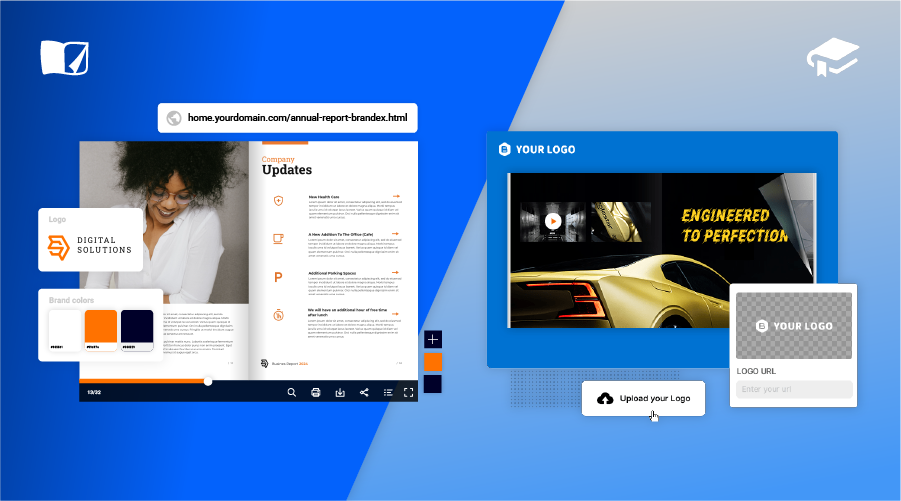
Better branding flexibility with Flipsnack
Flipsnack excels in letting companies create a fully branded flipbook experience. You can use a custom domain (CNAME) to publish flipbooks under your own web domain (e.g. publications.yourcompany.com) on both Flipsnack and FlipHTML5.
With Flipsnack, you can:
- Use a custom domain (CNAME) to publish under your own brand (e.g., catalogs.yourcompany.com)
- Customize the flipbook viewer’s interface, colors, logos, and even the loading screen
- Add your company logo inside the platform interface (dashboard & viewer)
- Enforce brand consistency with the Brand Kit (Enterprise only): save logos, colors, fonts, and templates for your team
Flipsnack allows adding your company logo inside the app interface for your team, meaning the dashboard or viewer can show your logo rather than Flipsnack’s, which FlipHTML5 does not support. It also has a Brand Kit feature for Enterprise plans, where you can save brand colors, fonts, and templates to ensure all content adheres to your identity.
All these touches ensure that when your audience views a Flipsnack publication, it feels like a seamless extension of your brand.
What about FlipHTML5? Basic branding, limited control
FlipHTML5 also offers some branding features, such as:
- Uploading your own logo to the flipbook
- Setting custom backgrounds or theme colors
- Using a custom domain (available on higher-tier plans)
These allow for a level of personalization, but the customization stops there. FlipHTML5 doesn’t support branded loading screens, player accent colors, or platform UI branding. There’s also no Brand Kit to store and apply your company’s assets across multiple projects.
Template options are also more limited in FlipHTML5, making it harder to maintain a consistent brand experience, especially for companies with strict visual guidelines.
They lack the full branding depth needed by enterprises or agencies managing multiple publications at scale. Flipsnack’s greater branding flexibility means you can ensure the Flipbook viewer aligns with your company’s look and feel at a level that FlipHTML5 cannot fully match.
Especially for client-facing materials or external communications, Flipsnack enables a more professional, cohesive brand experience for your audience. FlipHTML5 will still allow branding to an extent, but might leave a bit of a generic feel due to its limitations. If white-labeling and branding control are top priorities (for example, agencies or brand-conscious enterprises), Flipsnack is the stronger choice.

Scalability and automation
As your content needs to scale up (hundreds of catalogs, frequent updates, large data-driven publications), automation features become a huge plus. Here, Flipsnack provides more powerful automation and scalability options suited to enterprise demands, whereas FlipHTML5’s automation is minimal, requiring more manual work for large-scale tasks.
Flipsnack offers an automation feature that is especially beneficial for product catalogs and large content libraries. For example, Flipsnack can connect to external data sources like CSV files, Google Sheets, or Excel spreadsheets to import or update content in your flipbooks dynamically.
This is great for automating catalogs – you could link a spreadsheet of product details to your catalog template, and Flipsnack will populate or update the pricing, descriptions, etc., without you redesigning the PDF each time. Flipsnack supports real-time updates: if your data source changes (say inventory or pricing info), your Flipbook can be updated accordingly at the click of a button.
Another powerful feature is the Flipsnack’s Catalog Generator lets you automatically create multiple catalog variants (for different regions or clients, for instance) a huge time-saver for enterprises managing lots of content. And as your content library grows, Flipsnack’s automation ensures that you maintain efficiency and up to date informations.
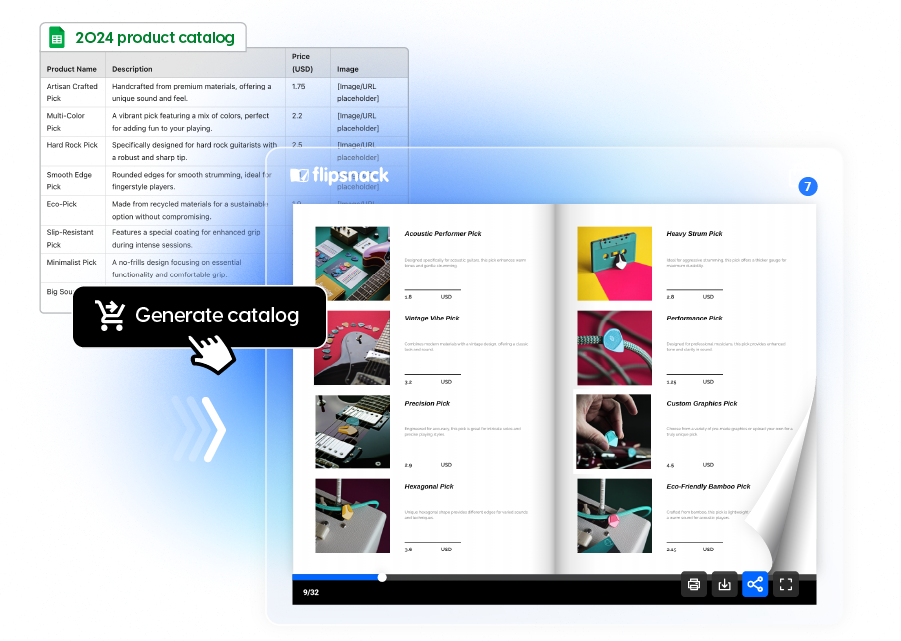
FlipHTML5 falls short on automation and scalability
FlipHTML5 has limited automation features. It is primarily a manual creation tool: you design or upload one flipbook at a time. FlipHTML5 does support importing a CSV file to create a basic table or something in a flipbook, but it’s far less integrated than Flipsnack’s data merge options. FlipHTML5 cannot auto-update content from external sources, so if your product details change, you’d have to regenerate or edit the flipbook manually and re-upload. It also doesn’t advertise any equivalent to a catalog batch generator or API for creating flipbooks programmatically (though
FlipHTML5 does have an API for managing, it appears focused on controlling single books via code, not bulk generation or data merging in the content itself.
If you deal with large volumes of content, Flipsnack’s automation features allow these tasks to be streamlined and even automated, saving time as you scale up content production. FlipHTML5 may suffice if your publishing needs are small-scale or infrequent, but it does not scale efficiently for complex or repetitive publishing workflows.
Analytics & Insights
Understanding how your audience interacts with your content is crucial for businesses. Both Flipsnack and FlipHTML5 recognize this and offer analytics, but Flipsnack provides deeper, more comprehensive analytics compared to FlipHTML5.
Flipsnack equips you with built-in flipbook performance statistics and tracking tools that give rich insights. Within Flipsnack, you can track:
- Views & impressions
- Average time spent per flipbook
- Clicks on interactive elements
- Downloads
- Device types (desktop, mobile, tablet)
- Bookshelf-level engagement (for shared collections)
For teams, Flipsnack provides activity logs as well, so admins can see actions taken by team members in the workspace (e.g., who updated what), though both platforms lack per-user contribution stats beyond that.
A standout feature is Flipsnack’s trackable links: you can generate unique URLs for a flipbook to distribute to different channels or audiences, and Flipsnack will track views and engagement separately for each link.
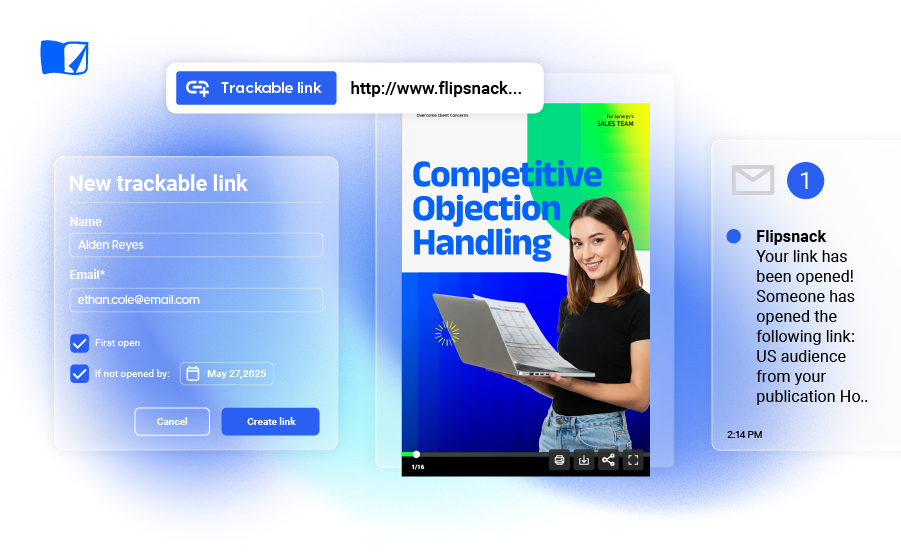
This is extremely useful for marketing campaigns – for example, you can create a trackable link for an email newsletter and another for social media and compare which channel drives more readers.
FlipHTML5 provides more basic analytics capabilities. It has built-in stats for each flipbook’s reads and perhaps some engagement data, but it is not nearly as granular as Flipsnack’s. FlipHTML5’s documentation highlights that it supports Google Analytics (GA4) and GTM integration as well, so you can track flipbook visits through Google’s ecosystem. This is good for marketing teams that already rely on GA.
You might see how many people read your flipbook and maybe the time spent, if using GA, but you won’t get, for instance, which pages were most viewed or where readers clicked (unless GA event tracking is manually set up). Essentially, FlipHTML5 covers the basics of flipbook analytics and leans on external tools for deeper analysis. It’s sufficient if you just need a rough idea of views or prefer to do all analysis in Google Analytics. But it’s not as self-contained or rich as Flipsnack’s analytics.

When you’re trying to optimize content (be it a sales catalog or a training manual), knowing detailed engagement stats and being able to A/B test via trackable links is invaluable. Flipsnack gives businesses more actionable analytics to work with, reducing the need to set up complicated third-party tracking. FlipHTML5 can certainly be tracked via GA for page views, but the depth of insight may be limited without additional setup.
Integrations (CRM, Adobe, etc.)
Modern organizations expect their software tools to play nicely with others. Integrations can extend a platform’s utility by connecting it to your existing systems (CRM, CMS, design software, etc.). Flipsnack offers a wider range of integrations and an API, making it easier to slot into enterprise toolchains, whereas FlipHTML5’s integrations are more limited (mostly covering generic web analytics and some automation via Zapier).
Flipsnack comes with an array of integration options that support enterprise workflows:
- Zapier integration which allows Flipsnack to connect to thousands of apps. Through Zapier, you can do things like automatically send Flipsnack lead form submissions into your CRM (e.g., HubSpot or Salesforce) or get notifications in Slack when someone views a flipbook.
- Google Analytics, Google Tag Manager, and Google Drive for analytics and content storage needs. Google Drive integration means you can import PDFs from Drive or save flipbook assets there directly.
- Adobe InDesign plugin/integration, this is a huge benefit for design teams: your designers can create layouts in InDesign and then export or import them seamlessly into Flipsnack to add interactivity and publish as a flipbook.
Flipsnack offers a well-documented REST API, enabling enterprises to integrate flipbook creation, user management, and workflows into their internal systems. It supports white-label integration and advanced automation. While FlipHTML5 also provides an API, Flipsnack’s is more robust and better suited for custom enterprise solutions.
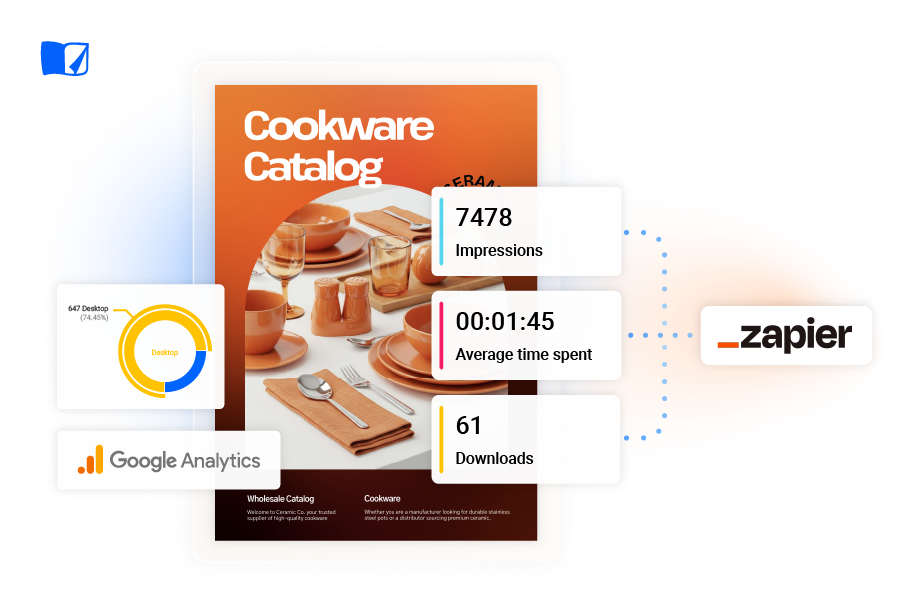
FlipHTML5 lacks any InDesign connection, so designers would have to export PDFs and then manually add interactivity in FlipHTML5’s editor. Flipsnack’s InDesign support smooth workflow for creative professionals by bridging the gap between design and online publishing.
FlipHTML5 supports far fewer direct integrations:
- Google Analytics and Tag Manager codes for tracking. This is almost a given for any web-based tool today.
- FlipHTML5 can work with Zapier in a limited capacity (though it’s not as prominently advertised). With some configuration, you could potentially use FlipHTML5’s API or RSS feed to trigger Zapier workflows, but it’s not as straightforward as Flipsnack’s Zapier support.
- FlipHTML5 does not list any Adobe integrations or direct connections to content creation tools, which suggests that creative workflows might be more manual (export PDF, re-import, etc.).
In essence, FlipHTML5 integrates with web analytics, and that’s about it – other connections would rely on their API and technical work on the user’s side, and even then, some things (like direct InDesign import) are simply not available.
Flipsnack vs FlipHTML5: AI for Accessibility and Efficiency
In the era of smart tools, both platforms have started adding AI-powered features and focusing on accessibility to improve content reach. Each takes a slightly different approach: Flipsnack’s AI features emphasize content translation and summary (accessibility and localization), while FlipHTML5’s AI assistant focuses on content creation and design enhancements. Both also address accessibility standards, though Flipsnack adds an AI twist.
Flipsnack’s AI Tools
Flipsnack introduced an “AI package” aimed at making content more accessible and easier to produce for global audiences. One major function is instant translation of text: Flipsnack can translate selected blocks of text or even entire flipbooks into multiple languages with a single click. This is incredibly useful for enterprises operating in multilingual markets – you can create an English brochure and quickly generate a Spanish or French version without leaving the platform.
Another AI feature is AI-generated summaries of pages. At the press of a button, Flipsnack’s AI can create a concise summary of a page’s content, which can be used as an accessibility aid (for screen readers) or a quick abstract for readers. This helps meet accessibility guidelines by providing alternate text summaries of complex layouts.
Flipsnack’s focus is clearly on AI that improves accessibility and efficiency – translation and summarization reduce manual work for localization and ADA compliance. As of early this year, it is also exploring content generation AI; features like AI-driven text rephrasing or image generation are on the roadmap. Even without those, Flipsnack’s current AI toolkit is tuned to enterprise needs: making content inclusive and globally usable with minimal effort.
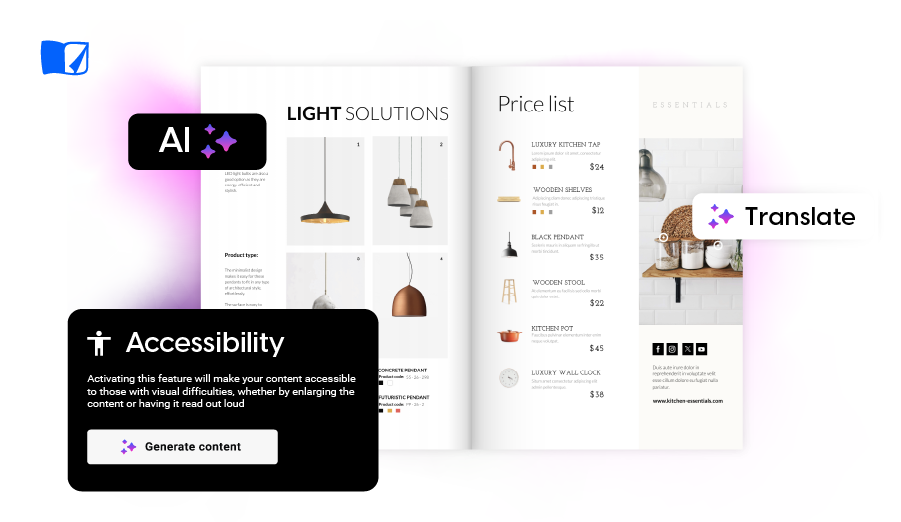
FlipHTML5’s AI Assistant
FlipHTML5 has an AI Assistant that acts more like a creative partner in the content creation process. Using technologies akin to ChatGPT, FlipHTML5’s AI can help generate new text, rewrite or polish existing text, and even create images from text prompts. Essentially, if you have a rough draft of content, the AI assistant might improve the copy, or if you need an image, it can attempt to generate one based on your description. FlipHTML5 also mentions AI chatbots that can be embedded and multi-language support (translation) in up to 30 languages.
However, notably, FlipHTML5 does not offer full-document automatic translation like Flipsnack does – can translate snippets on request but not the entire flipbook in one go.
One downside is that relying on AI-generated content may not be as critical a need for enterprises, who often have in-house content teams and strict brand voice guidelines. Also, the quality of AI-generated text/images can vary, so enterprises might use it sparingly. In contrast, automated translation and summary (which Flipsnack offers) provide immediate practical benefits for localization and accessibility.
Both Flipsnack and FlipHTML5 address accessibility features such as:
- Keyboard navigation and screen reader support: Their online viewers allow navigation via keyboard and are structured in a way that screen readers can interpret, meeting baseline WCAG guidelines for online documents.
- Alt text for images or pages: Creators can add alternative text descriptions to images or even to whole pages so that visually impaired readers get descriptions via screen readers.
- Reading order control: Both allow arranging layers or content order, ensuring the logical reading order is correct for assistive technologies.
For enterprise organizations, accessibility isn’t just about doing right by users with disabilities; it’s often a legal requirement (for example, complying with ADA or EU accessibility directives for digital content). Flipsnack’s built-in features to support accessibility (like screen reader support and AI page summaries) make it easier to ensure all audiences can consume your digital publications.
Additionally, if your focus is on utilizing cutting-edge AI for creative content generation, FlipHTML5 shows strength there with its AI Assistant (which Flipsnack is catching up on). In the long run, Flipsnack is also integrating those generative AI features, making it a strong choice for future AI-powered content creation.
FlipHTML5 vs Flipsnack? And why Flipsnack is better for your business needs
Both platforms offer interactive digital publishing tools, but they serve different audiences. Flipsnack is purpose-built for enterprise teams, offering advanced branding, security, collaboration, and analytics—everything large organizations need to scale securely and efficiently. Its intuitive interface, combined with enterprise-grade features, makes it ideal for teams who value both creative control and corporate governance.
Flipsnack is the stronger choice. FlipHTML5 can certainly publish beautiful flipbooks, but Flipsnack stands out as the more advanced and business-focused platform, designed to meet high-level requirements and support growth. It is the flipbook solution more likely to satisfy IT departments, content managers, and marketers.
If you need a true FlipHTML5 alternative that will grow with your organization and provide a secure, all-in-one space for creating, collaborating on, and tracking interactive content, Flipsnack is likely to be the tool for you and your team. It not only matches FlipHTML5 on core features but exceeds it in the areas that matter for enterprises: security, collaboration, branding, integrations, and analytics.
I also want to give credit where credit is due, and highlight that FlipHTML5 remains a valid option for professionals looking to work on projects individually. The interactions package that this tool offers requires a certain level of tech-savviness, and experience in the design world. The way this tool outlined the overview of different elements on a page shows similarities with PremierPro, which would make the learning process a bit more difficult for marketers that aren’t familiar with such tools.
